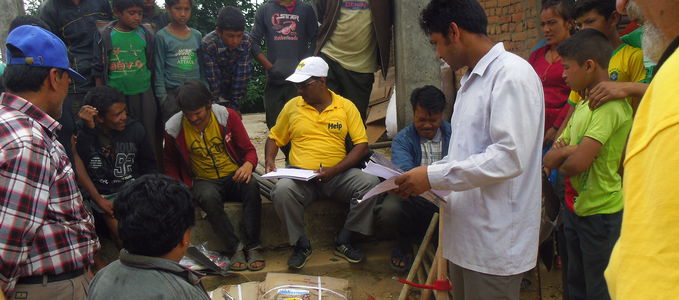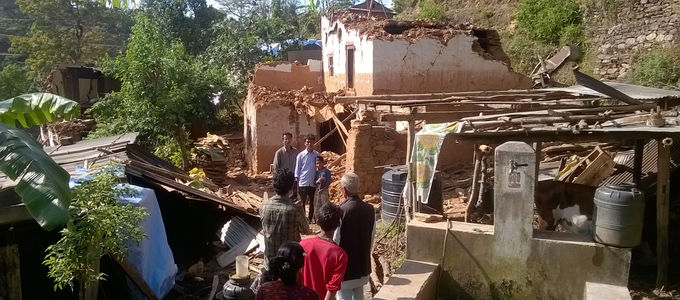
Just two months after the devastating earthquake, the impending monsoon season is just about to make the situation in Nepal even more dramatic. The rains are going to hurt the nearly three million people who have lost their homes the hardest. This is what the scores of aid organisations are currently preparing for, among them also New Apostolic institutions.
It is twelve noon and the family of Krishna Bahadur Dulal is working in their field in the small village of Thulo Sirubani. Suddenly they feel the ground shake beneath their feet. “We were terribly afraid,” Krishna reports. An earthquake with a magnitude of 7.9 has struck Nepal. It is 25 April 2015. As soon as the tremors stop, the family runs home only to find that all that is left of their house is a pile of rubble.
Working with partners
Krishna wants to build a new house. But he neither has money nor building material—far from it. But then came a glimmer of hope for Krishna. On 7 May 2015 he was given a tarpaulin. Standing in front of his house with it he said, “At least now we can build ourselves a temporary shelter.” The tarpaulin for his family and 600 others was provided by a relief organisation from Germany, Help – Hilfe zur Selbsthilfe e.V. (“Help for self-help”).
In the wake of the war in Afghanistan and the ensuing refugee crises, members of Parliament of all parties represented in the German Parliament and other distinguished personalities founded Help in July 1981. It is a humanitarian aid and development organisation that operates worldwide. Help is assisted by numerous partner organisations. One of them is NAK-karitativ, which was established by several New Apostolic District Churches from Germany. The institution has provided an initial 30,000 euros in emergency aid.
A roof over their heads
According to the United Nations, about half a million homes were destroyed by the earthquake in Nepal in April and during a second major earthquake only a few weeks later. Some 350,000 families are still without emergency shelters. Anyone who has managed to find a spot in one of the 400 make-shift camps or has maybe even managed to put together a make-shift shed, usually lives under a bamboo structure or under tarpaulins. Most people are just coping. But these shelters will no longer do. The impending monsoon is making things look even grimmer. The rains usually last more than a hundred days. The people desperately need a proper roof over their heads.
The New Apostolic Church Canada, who cares for the brothers and sisters in Nepal, is very much aware of this too and has concentrated its efforts in the region of Sipapokhare and Sipaghat (Dharkhola) in the eastern part of the country. After basic supplies such as blankets, food, and water were delivered to the region, the Church is planning on supplying corrugated iron sheets that can be used as roofs. The building of proper sanitation facilities is also planned. Currently, the lack of sanitation facilities is among the biggest health risks in Nepal. Some 1.1 million people are affected.
In line with the United Nations
The New Apostolic Church Canada has so far responded with some 35,000 dollars. The New Apostolic Church in Southern Germany has responded with another 10,000 euros. On top of this, the District Church in Southern Germany, via its own relief organisation Missionswerk, has donated an additional 30,000 euros to another interdenominational organisation that provides health care and medical aid during disaster relief operations.
NAK-Humanitas, the relief organisation of the New Apostolic Church Switzerland, has responded by giving money to two organisations who are working in Nepal. 25,000 euros have been donated to Save the Children, the world’s leading independent organisation for children. Another 25,000 euros have gone to the Red Cross. By focusing their priorities on these two institutions, the aid organisations of the New Apostolic Church are targeting the most pressing needs set out by the United Nations: the medical care of children and nursing mothers.
Practising one’s faith in times of dire hardship
Further measures are being planned by the New Apostolic Church Canada and by NAK-karitativ. A long-term plan is being developed to help with building materials and repairs. But this can only be started once the monsoon season ends.
The brothers and sisters in Nepal continue to live their faith despite great hardship. Divine services continue to be held whether in our damaged church in Kathmandu or in the house of a Priest in Sipaghat (Dharkhola), where our church was destroyed. The congregations in Sipapokhare and Sipaghat have just had a visit from their Bishop Shrestha.






















